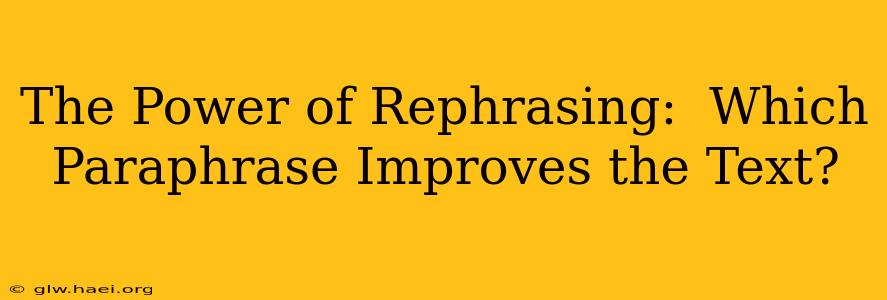The Power of Rephrasing: Which Paraphrase Improves the Text?
The ability to rephrase, to recast words and sentences into clearer, more impactful forms, is a superpower in communication. It's the difference between a muddled message and one that resonates, between confusion and clarity, between a reader who glances away and one who's captivated. But choosing the best paraphrase isn't always obvious. Let's explore this crucial skill, focusing on how to identify which rephrased version truly elevates the original text.
Imagine you're editing a piece of writing. The original sentence reads: "The data indicated a significant increase in customer satisfaction following the implementation of the new software." Now, consider these paraphrases:
- Paraphrase A: "The new software made customers happier."
- Paraphrase B: "After installing the new software, customer satisfaction rose noticeably."
- Paraphrase C: "Customer satisfaction showed a marked improvement post-software implementation, as evidenced by the data."
Which paraphrase is best, and why? Let's delve into the nuances.
What Makes a Good Paraphrase?
A strong paraphrase achieves several key goals:
-
Clarity: It simplifies complex language without losing meaning. Paraphrase A, while concise, sacrifices some of the original's precision. "Happier" is subjective; "significant increase" is quantifiable.
-
Accuracy: It retains the original meaning completely. Paraphrase C, though grammatically correct, uses overly formal language and might not be accessible to all readers. While accurate, it's less impactful.
-
Style: It fits the overall tone and style of the writing. Paraphrase B effectively maintains the original's formal tone while improving readability. It's clear, concise, and easily understood.
-
Conciseness: It avoids unnecessary words or phrases without sacrificing meaning.
Analyzing the Paraphrases
Let's revisit each paraphrase in light of these criteria:
-
Paraphrase A: While concise, it lacks the precision and formality of the original. It's suitable for informal settings but not ideal for academic or professional writing.
-
Paraphrase B: This is the strongest paraphrase. It maintains accuracy and formality while improving clarity and readability. The language is straightforward and easily understood.
-
Paraphrase C: This paraphrase is accurate but overly formal and wordy. While demonstrating a thorough understanding of the original, it lacks the impact and readability of Paraphrase B.
How to Choose the Best Paraphrase
The process of selecting the optimal paraphrase involves several steps:
-
Understand the original meaning: Ensure you fully grasp the original sentence's intent and key concepts.
-
Consider the context: The appropriate paraphrase will depend on the audience and the overall style of the writing.
-
Compare and contrast: Evaluate each paraphrase against the criteria of clarity, accuracy, style, and conciseness.
-
Prioritize clarity and accuracy: These are the most important elements of a successful paraphrase.
-
Seek feedback: If possible, get another set of eyes to review your chosen paraphrase.
Beyond Simple Sentences: Rephrasing Complex Ideas
The principles discussed here apply equally to more complex sentences and paragraphs. The goal remains consistent: to convey the same information more effectively. This often involves breaking down lengthy sentences, re-organizing information logically, and selecting stronger, more precise vocabulary.
Mastering the art of rephrasing transforms your writing, making it more compelling, accessible, and impactful. By focusing on clarity, accuracy, and style, you can ensure your message resonates with your audience.

